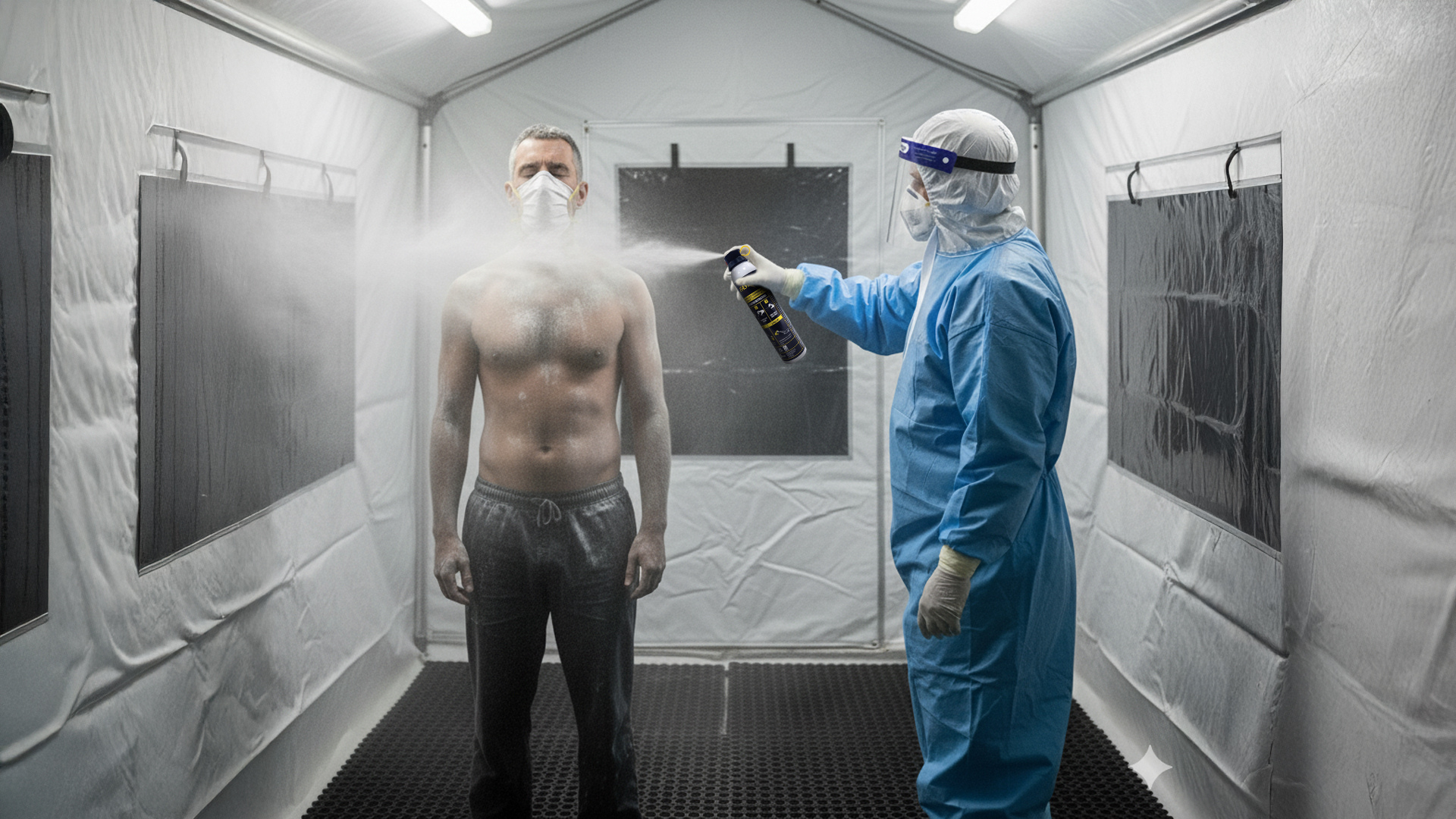FAST-ACT’s Hospital SOP: Advancing Chemical Decontamination Preparedness
Hospitals are on the front lines of mass casualty incidents where patients may arrive contaminated with chemical agents or other hazardous materials. Whether the source is an industrial accident, a deliberate attack, or exposure to toxic industrial chemicals (TICs), medical teams must balance urgent treatment with strict decontamination procedures to protect both patients and staff.
FAST-ACT® has developed a comprehensive Hospital SOP that guides healthcare facilities in handling these emergencies safely. The SOP combines proven decontamination techniques with advanced dry decontamination systems, providing hospitals with practical tools for rapid response.
In this blog, we will cover the essential steps of the FAST-ACT hospital SOP, explain how the FAST-ACT Pressurized Cylinders, FAST-ACT Decontamination Mitts, and FAST-ACT Decontamination Wipes are applied, and highlight the supporting science behind these hospital-focused decontamination protocols.
Step 1 & 2: Purpose and Scope
Every decontamination facility must begin with preparation. Patients are first given a disposable face shield and an FFP2/N95/KN95 mask to prevent inhalation of airborne contaminants. At the same time, medical staff— emergency responders—must wear personal protective clothing suitable for hazmat decontamination and chemical incident response.
Patients are then directed into the designated contamination reduction zone or decontamination line, which may include temporary decontamination stations or a permanent hospital decon facility. This setup ensures patient safety while minimizing the spread of contaminants into clean hospital areas.
Step 3: Primary Chemical Decontamination with the Pressurized Cylinder
At the center of FAST-ACT’s Hospital Decontamination SOP is the FAST-ACT® 400g Pressurized Cylinder. This tool provides almost immediate vapor, skin, and surface decontamination during emergency decontamination procedures.
Once contaminated clothing is removed and placed in hazardous waste bags, the cylinder is discharged evenly over the patient and their clothing in bag. This step takes only 10–15 seconds but plays a critical role in neutralizing chemical agents and preventing dangerous off-gassing. Unlike traditional decon solutions, the dry powder system uses adsorbent materials to capture and neutralize contaminants without water, which is particularly valuable in mass casualty events or when water supplies are limited.

Step 4: Secondary Spot Treatment: FAST-ACT Decontamination Mitts and FAST-ACT Decontamination Wipes
Not all contaminated surfaces are covered by clothing. For exposed areas, FAST-ACT provides targeted Decontamination Mitts and Decontamination Wipes. These tools are designed for patient decontamination when sensitive areas or skin are exposed to toxic substances.
The mitt is used to gently pat the skin, allowing the powder to adsorb and neutralize harmful agents. The wipes provide a softer application for delicate regions, ensuring effective surface decontamination without damage to skin. Both products are CE classified as a class I medical device for use on skin. Also, serving as vital decontamination technique for ensuring complete chemical neutralization before transitioning to a water rinse.

Step 5: Transition to Water Decontamination
After dry decon procedures, patients move to water decontamination showers. Tepid or warm water is used to rinse away FAST-ACT powder, finalizing the decontamination procedure. This process, lasting between one and five minutes, is critical for both patient safety and compliance with Decontamination Procedures Guidelines recognized in CBRN response plans.
It is also important to understand when to use dry decontamination, when to use wet decontamination, and when to use a combination of both. Dry decontamination is often preferred in the initial stages of a mass casualty incident, particularly when water supplies are limited, when there is risk of spreading contaminants through runoff or off-gassing, or when immediate containment is required. Wet decontamination, on the other hand, provides a thorough rinse of the skin and is essential for completing the process. In many cases, the most effective approach is a layered response—using dry decon for rapid neutralization followed by water-based decon to ensure full removal of hazardous agents.
Step 6: Sensitive Equipment Decontamination
Not all contaminated materials can withstand water exposure. Sensitive equipment—such as electronic devices, monitoring instruments, or medical tools—requires a dry decontamination method to avoid damage while ensuring safety.
FAST-ACT’s dry decontamination system allows hospitals to neutralize chemical contaminants on these items without moisture. Using the FAST-ACT Pressurized Cylinder, responders can apply an even layer of powder to the equipment’s surface to adsorb and neutralize harmful agents. After application, excess powder can be carefully removed using a HEPA-filtered vacuum system, ensuring complete removal of contaminants without compromising the equipment’s integrity. This process provides a safe, water-free solution for maintaining operational readiness of essential devices in the aftermath of a chemical incident.
Non-Sensitive Equipment Decontamination
For equipment and surfaces that can tolerate moisture, FAST-ACT dry decontamination can be followed by a water-based rinse to ensure full contaminant removal. After applying the FAST-ACT Pressurized Cylinder or Mitts to neutralize chemical agents, staff should rinse the treated surfaces with warm water to wash away residual powder and absorbed contaminants.
All used decontamination materials and rinse water should be handled according to hazardous waste disposal guidelines. This dual-step process ensures that non-sensitive tools and hospital infrastructure are fully decontaminated and ready for reuse while maintaining compliance with hospital safety and environmental standards.
Step 7: Post-Decontamination and Disposal Methods
Dispose of all used decontamination tools — cylinders, mitts, wipes — and contaminated clothing as hazardous waste in accordance with local regulations and hospital policy.
Scan decontamination areas for residual contamination per local clearance protocols. In the Primary Decontamination area sweep and collect FAST-ACT powder residue. If required, perform a final cleanup with a HEPA-filtered industrial vacuum. In Water-Based Decontamination stations rinse remaining residue to approved collection drains.
Handle used cylinders and product waste while wearing appropriate PPE. Store sealed/labelled waste containers in the designated hazardous-waste holding area for onsite disposal or transfer to an authorized hazardous-waste facility, following local waste-management procedures.
Medical Management and Scientific Validation
FAST-ACT’s system is designed to support both emergency healthcare providers and the larger infrastructure of disaster response. Independent studies confirm that FAST-ACT neutralizes a broad spectrum of CWAs and TICs, reducing residue to levels compliant with NATO standards.
For example, third-party testing showed that FAST-ACT reduced sulfur mustard contamination on hair swatches from hazardous AEGL 2 levels to below AEGL 1, meeting mass casualty incident response thresholds. Research also indicates that the system does not interfere with wound healing, further supporting its role in medical management.
For additional reference, see CDC’s Chemical Emergencies Resources and NATO’s CBRN Medical Guidelines, both of which outline best practices for decontamination procedures and CBRN response plans.
Why Hospital Decontamination Protocols Matter
Effective hospital decontamination is more than a safety requirement—it is a cornerstone of disaster response. Without clear, tested decontamination protocols, hospitals risk secondary exposures, delays in patient decontamination, and compromised medical care.
By incorporating FAST-ACT’s dry decon procedures, hospitals gain a decontamination system that is fast, scalable, and proven. This ensures that emergency responders, hazardous material teams, fire departments, and emergency healthcare providers have the tools they need to safeguard patient care during mass casualty events while maintaining control and effective crowd control measures in high-stress environments.
FAST-ACT’s Hospital SOP provides hospitals with tested, evidence-based decontamination techniques that protect patients, staff, and facilities when every second counts.
Learn more about FAST-ACT hospital preparedness solutions by contacting our team.
About Timilon Corporation:
Timilon Corporation is the manufacturer of FAST-ACT®, a proprietary formulation of non-toxic high-performance specialty materials effective at neutralizing a wide range of toxic chemicals with the added capability to destroy chemical warfare agents. The FAST-ACT technology is utilized by leading defense agencies, chemical industrial companies, first responders and HAZMAT teams to quickly and safely eliminate chemical hazards. For more information, reach out to Leticia Menzzano, Marketing Manager, lmenzzano@timilon.com.

